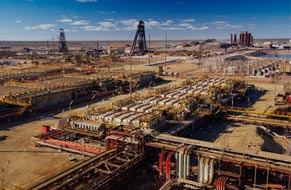Olympic Dam output impacted by incident
21 October 2009
BHP Billiton expects copper and uranium production at its Olympic Dam underground mine in South Australia to be significantly reduced for at least four to six months while the damaged ore haulage system in the main shaft is repaired.
 |
| Olympic Dam (Image: BHP Billiton) |
The company said that a full investigation is underway to determine the extent of the damage in the Clark shaft. No-one was injured in the incident, which occurred at about 10:30 p.m. on 6 October.
BHP has not released details on the cause of the failure, but media reports suggested that a fully-loaded ore skip fell to the bottom of the 500-metre deep shaft, sending another skip on a linked cable flying up into the winding equipment at the top of the shaft, damaging the concrete walls of the shaft on its way.
The Clark shaft haulage system supplies ore from underground to the surface processing facilities. BHP said that the secondary haulage system, in the Whenan shaft, continues to operate. However, it said that ore hoisting will be about 25% of capacity until full production resumes by the end of March 2010. This will result in the loss of some 900 to 1400 tonnes U3O8 production.
Media reports suggest that BHP will declare force majeure on near-term copper and uranium contracts, excusing the company from not performing its contractual obligations due to the unforeseen reduced production at Olympic Dam. This could lead to an increase in the price of copper and uranium as BHP's customers seek alternative sources.
Olympic Dam is the world's largest known uranium orebody, as well as laying claim to the world's fourth largest remaining copper deposit, fifth largest gold deposit and significant quantities of silver. It produces uranium as a co-product with copper.
The mine produced 3344 tU in 2008, winning it fourth place in the world's top ten uranium mines and accounting for 8% of total world uranium production. However, BHP Billiton is looking to massively increase the size of the mine over coming decades, and earlier this year released a 4000-page draft environmental impact statement (EIS) on its proposed expansion plans. Government decisions on the draft EIS are expected by the middle of 2010. The proposed expansion would take 11 years to implement, and would see production of up to 19,000 tonnes U3O8 per year.